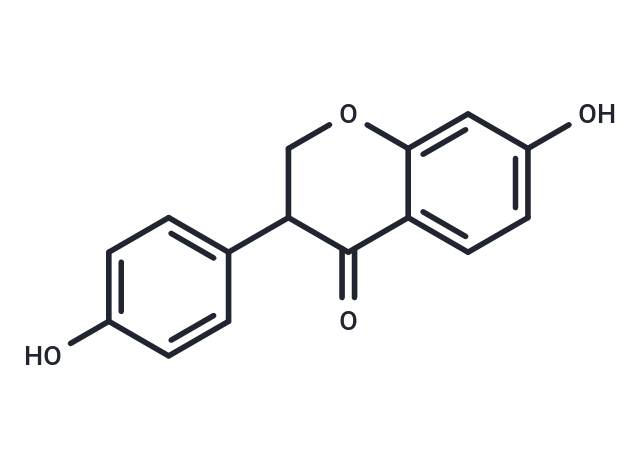Shopping Cart
- Remove All
 Your shopping cart is currently empty
Your shopping cart is currently empty

Dihydrodaidzein ((±)-Dihydrodaidzein)-producing bacteria might lead to clarification of some of the mechanisms regulating the production of equol by fecal microbiota.

| Pack Size | Price | Availability | Quantity |
|---|---|---|---|
| 1 mg | $38 | In Stock | |
| 5 mg | $82 | In Stock | |
| 10 mg | $118 | In Stock | |
| 25 mg | $195 | In Stock | |
| 50 mg | $287 | In Stock | |
| 100 mg | $425 | In Stock | |
| 200 mg | $635 | In Stock | |
| 1 mL x 10 mM (in DMSO) | $91 | In Stock |
| Description | Dihydrodaidzein ((±)-Dihydrodaidzein)-producing bacteria might lead to clarification of some of the mechanisms regulating the production of equol by fecal microbiota. |
| In vitro | Recently, we isolated a Dihydrodaidzein (DHD)-producing Clostridium-like bacterium, strain TM-40, from human feces. We investigated the effects of strain TM-40 on in vitro daidzein metabolism by human fecal microbiota from a male equol producer and two male equol non-producers. In the fecal suspension from the male equol non-producer and DHD producer, DHD was detected in the in vitro fecal incubation of daidzein after addition of TM-40. The DHD concentration increased as the concentration of strain TM-40 increased. In the fecal suspension from the equol producer, the fecal equol production was increased by the addition of strain TM-40. The occupation ratios of Bifidobacterium and Lactobacillales were higher in the equol non-producers than in the equol producer. Adding isoflavone-metabolizing bacteria to the fecal microbiota should facilitate the estimation of the metabolism of isoflavonoids by fecal microbiota[1] |
| Alias | (±)-Dihydrodaidzein |
| Molecular Weight | 256.25 |
| Formula | C15H12O4 |
| Cas No. | 17238-05-0 |
| Smiles | Oc1ccc(cc1)C1COc2cc(O)ccc2C1=O |
| Relative Density. | 1.386g/cm3 |
| Storage | Powder: -20°C for 3 years | In solvent: -80°C for 1 year | Shipping with blue ice. | |||||||||||||||||||||||||||||||||||
| Solubility Information | DMSO: 100 mg/mL (390.24 mM), Sonication is recommended. | |||||||||||||||||||||||||||||||||||
Solution Preparation Table | ||||||||||||||||||||||||||||||||||||
DMSO
| ||||||||||||||||||||||||||||||||||||

Copyright © 2015-2025 TargetMol Chemicals Inc. All Rights Reserved.